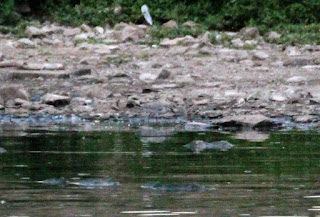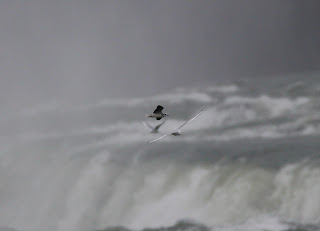2016 was an amazing year for rarities (check out my post on a 2016 Ontario Big Year for a list of rare birds). I didn't get to see all of them (Common Ringed Plover and Crested Caracara being the most painful not to see), but I caught up with a few of them.
The first rarity I was successful in seeing was a Greater White-fronted Goose in London.
This is typically more a "western goose", however large numbers showed throughout 2016. This individual was somewhat tame, and many birders got close enough to take decent photos. The bird that showed up in London appeared to be a "Greenland" type.
Nearly a month later a Gyrfalcon showed up in Warwick, Lambton.
The bird stayed for at least a month, and offered great views. This Gyrfalcon was a gray morph, and appeared to be male. Great bird for Southern Ontario!
A week after the Gyr, an Eurasian Wigeon showed up in Lambton as well. I didn't get a picture, nor did I get a good look at the bird, but it was a Euro Wigeon nonetheless, so it was a great find.
The next rare bird I was able to lay my eyes on were Loggerhead Shrikes.
While a regular breeder in Ontario, they are only about a dozen pairs in the province. Carden Alvar boasts over half of these pairs, and this is where I found the Shrikes.
Piping Plovers aren't really "rarities" in Ontario, but finding a successful nesting pair sure is!
Darlington Provincial Park hosted two successful broods in 2016, the first in over 80 years! I'm not alone in hoping for their return this year.
An Eurasian Collared-Dove the next week was a great bird in Guelph.
The Eurasian Collared-Dove is making it's way northward, and I'm sure it won't be long before they regularly breed in the province.
Marbled Godwit was next almost a month later in Hamilton.
Marbled Godwits are hard to come across in Ontario, with only a few records, if any, each year.
I saw a Red Knot the same evening as the Marbled Godwit in Hamilton.
The light was fading fast, but I managed to find the bird and get a some record shots. Red Knots migrate in the thousands through Ontario way up north along Hudson and James bay, but we usually only find around a dozen down here in southern Ontario.
Two months later I catch up with another rarity...Cattle Egret in Blenheim.
Like the Greater White-fronted Goose, 2016 was a great year for Cattle Egrets in the province as well, and there could have been as many as two dozen, maybe even more.
November was highlighted by a Western Sandpiper at the Blenheim Sewage Lagoons. This bird sure made people confused. Originally identified as a Semipalmated Sandpiper, It wasn't until a couple weeks into it's visit that the possibility of it being a Western really got going. After a few days of debate and examining pictures, we reached the conclusion of it being a WESA. I would have attempted for a photo if I knew it was a WESA, but I figured that I've seen lots of Semis, so I don't need any photos. I'm kicking myself now!
A Red-headed Woodpecker was a great local rarity that I found (with the assistance of some companions) on the London CBC4Kids.
RHWO are hard to come across during the breeding season, and even harder to find in the Winter. The bird this past December was a juvenile.
A female King Eider in Hamilton was a great bird.
King Eiders are regular but usually hard to find. So far this winter has been a good one for this duck. I'm sure it's just a matter of time before an adult male is found.
Black Vultures are a Niagara specialty.
Black Vultures are becoming increasingly more common in Ontario, especially along the shores of Lake Ontario and Lake Erie. They can be separated from Turkey Vultures by the silvery spot on the tips of their wings.
My last rarity of 2016 was a Little Gull.
I've been searching for Little Gulls since I first learned about this species in July, 2015 (not all that far back, but I started birding in March, 2015). 2016 wasn't the best year for this rare gull species, but those who do a little birding in Niagara are usually successful. They can be separated from a Bonaparte's Gull by their dark underwing.
Well their you have it. All the rare birds I saw in 2016. Hopefully 2017 will be even better, and I'm already off to a great start!













Little Gulls were certainly scarce in 2016 compared to some years. My biggest number at Rondeau once was 13 around the end of July!
ReplyDeleteWell, their absence last year was made up by numerous other species.
Delete